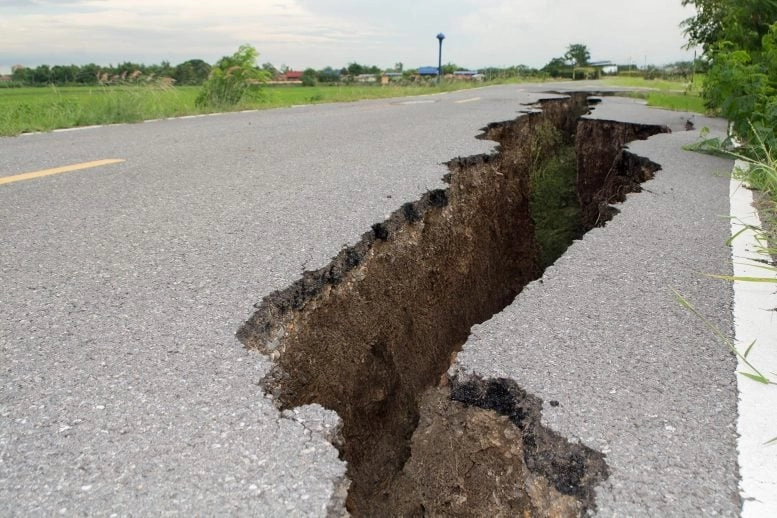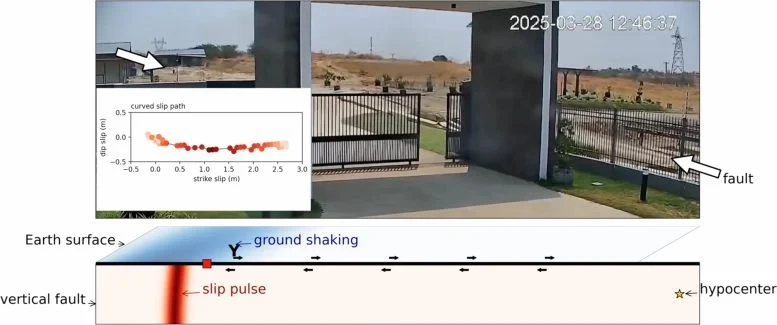 A CCTV video from Myanmar has revealed the first direct footage of a curved fault slip during an earthquakeconfirming long-held geological theories and deepening our understanding of rupture dynamics. Credit: Shutterstock
A CCTV video from Myanmar has revealed the first direct footage of a curved fault slip during an earthquakeconfirming long-held geological theories and deepening our understanding of rupture dynamics. Credit: Shutterstock
In a breakthrough moment, researchers captured the first-ever video of curved fault slip during Myanmars recent magnitude 7.7 earthquakesomething long suspected from geological evidence but never seen in action.
The astonishing footage, posted to YouTube, sparked a deeper analysis by geophysicists who confirmed that the slip followed a downward-curved path, matching patterns previously deduced from ancient slickenlines.
Thrilling Discovery From Earthquake CCTV
A recently uploaded CCTV video from Myanmar showing a fault slipping during a powerful earthquake quickly captured attention on YouTube, exciting both geologists and everyday viewers. But for geophysicist Jesse Kearse, it wasnt until his fifth or sixth time watching that he noticed something even more remarkable.
Kearse, along with his colleague Yoshihiro Kaneko from Kyoto University, took a closer look at the footage and realized it contained what may be the first direct visual documentation of curved fault slip.
Geologists studying earthquakes have long observed curved slickenlinesgrooved markings left behind when blocks of rock move past one another during faulting. However, until this video surfaced, scientists had not seen visual confirmation that such curved slip motion actually occurs.
CCTV footage of the fault slip during the 2025 Myanmar Earthquake.
First Glimpse of Curved Fault Slip
In their study published in The Seismic Record, Kearse and Kaneko explain that this footage provides key insight for improving computer models of how earthquakes unfold and faults rupture.
The video was recorded by a security camera positioned near the surface trace of the Sagaing Fault in Myanmar. On March 28, a magnitude 7.7 earthquake ruptured the fault. The camera, located roughly 20 meters (~65 feet) east of the fault and about 120 kilometers (~75 miles) from the earthquakes hypocenter, captured what appears to be the ground shifting in real time.
What makes the footage extraordinary is the clarity with which it shows the fault in motion. After the initial shaking, viewers can clearly see the land to the west of the fault moving northwarda striking, real-world visualization of seismic forces in action.
 CCTV caught footage of the earthquake. Credit: KyotoU / Jesse Kearse
CCTV caught footage of the earthquake. Credit: KyotoU / Jesse Kearse
Chills and Curves: A Scientists Obsession
I saw this on YouTube an hour or two after it was uploaded, and it sent chills down my spine straight away, Kearse recalled. It shows something that I think every earthquake scientist has been desperate to see, and it was just right there, so very exciting.
Watching it over and over again, he noticed something else.
Instead of things moving straight across the video screen, they moved along a curved path that has a convexity downwards, which instantly started bells ringing in my head, Kearse said, because some of my previous research has been specifically on curvature of fault slip, but from the geological record.
Connecting Video to Past Earthquakes
Kearse had studied curved slickenlines associated with other earthquakes, such as the 2016 magnitude 7.8 Kaikoura earthquake in New Zealand, and their implications for understanding how faults rupture.
With the Myanmar video, we set about to quantify the movement a bit more carefully, to extract objective quantitative information from the video rather than just pointing at it to say, look, its curved, he said.
The researchers decided to track the movement of objects in the video by pixel cross correlation, frame by frame. The analysis helped them measure the rate and direction of fault motion during the earthquake.
Pulse-Like Quake Motion Quantified
They conclude that the fault slipped 2.5 meters for roughly 1.3 seconds, at a peak velocity of about 3.2 meters per second. This shows that the earthquake was pulse-like, which is a major discovery and confirms previous inferences made from seismic waveforms of other earthquakes. In addition, most of the fault motion is strike-slip, with a brief dip-slip component.
The slip curves rapidly at first, as it accelerates to top velocity, then remains linear as the slip slows down, the researchers found.
The pattern fits with what earthquake scientists had previously proposed about slip curvature, that it might occur in part because stresses on the fault near the ground surface are relatively low.
Groundbreaking Implications for Fault Dynamics
The dynamic stresses of the earthquake as its approaching and begins to rupture the fault near the ground surface are able to induce an obliquity to the fault movement, said Kearse.
These transient stresses push the fault off its intended course initially, and then it catches itself and does what its supposed to do, after that.
The researchers previously concluded that the type of slip curvaturewhether it curves in one direction, or in the otheris dependent on the direction that the rupture travels, and is consistent with the north to south rupture of the Myanmar earthquake. This means that slickenlines can record the dynamics of past earthquakes, which can be useful for understanding future seismic risks.
Reference: Curved Fault Slip Captured by CCTV Video During the 2025 Mw 7.7 Myanmar Earthquake by Jesse Kearse and Yoshihiro Kaneko, 18 July 2025, The Seismic Record.
DOI: 10.1785/0320250024
Never miss a breakthrough: Join the SciTechDaily newsletter.



